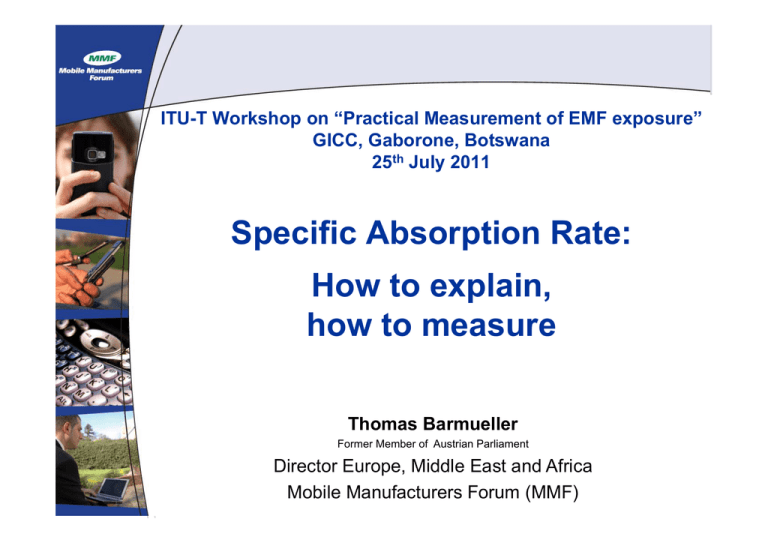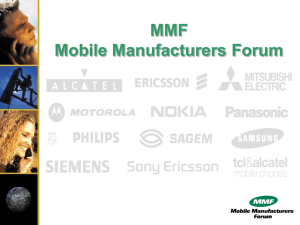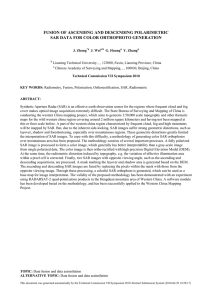Specific Absorption Rate: How to explain, how to measure
advertisement

ITU-T Workshop on “Practical Measurement of EMF exposure” GICC, Gaborone, Botswana 25th July 2011 Specific Absorption Rate: How to explain, how to measure Thomas Barmueller Former Member of Austrian Parliament Director Europe, Middle East and Africa Mobile Manufacturers Forum (MMF) 1 Presentation Overview 1. 2. 3. 4. 5. Background to the MMF Standards: International Developments How to explain Specific Absorption Rate (SAR) How to measure SAR Summary 2 Background to the MMF • International association of radio equipment manufacturers, founded 1998 ¾ ¾ • Association's focus: ¾ • Representing around 80% of global handset sales; and The providers of the majority of global network infrastructure Health and safety Key areas of activity: ¾ ¾ ¾ Research and standards support Regulatory harmonisation Public communications 3 MMF Members ¾ ¾ ¾ ¾ ¾ ¾ ¾ ¾ ¾ ¾ ¾ ¾ Apple Cisco Ericsson Intel LG Motorola Mobility Motorola Solutions Nokia Nokia Siemens Networks Samsung Sony Ericsson TCT Mobile (Alcatel Mobile Phones) 4 Presentation Overview 1. 2. 3. 4. 5. Background to the MMF Standards: International Development How to explain Specific Absorption Rate (SAR) How to measure SAR Summary 5 International developments • Science-based approach prevails as countries around the world have adopted ICNIRP limits. • Also ITU recommends:* “If such limits do not exist, or if they do not cover the frequencies of interest, then ICNIRP limits (Appendix I) should be used.” (*ITU-T K.52 (12/04) - Guidance on complying with limits for human exposure 6 to electromagnetic fields), see also K.52 Corrigendum 1 (05/2009) International developments • Brazil: ¾ Since 2002, ICNIRP limits had been in force based on Resolution # 303, issued by Brazilian National Telecommunication Agency ANATEL. ¾ In May 2009, ICNIRP’s scientific rationale and limits stipulated by federal law #11934/2009. ¾ The order applies to both network infrastructure and handsets well as all the other radio systems (TV broadcasting, radio broadcasting, two ways radios, etc) 7 International developments • China: ¾ In August 2008, China officially adopted ICNIRP based limits for handsets. ¾ Limits for base stations are currently being prepared but MIIT has stated they see no reason for these limits not to be also based on ICNIRP. 8 International developments • India: ¾ In September 2008, the Telecom Commission of India formally adopted ICNIRP guidelines in India. ¾ The order applies to both network infrastructure and handsets. ¾ India is currently in the process of adopting exposure measurement standards and is looking carefully at the existing European and international (IEC) standards. 9 International developments • Russia: ¾ Russia’s current EMF limits were developed before mobile communications was available. At that time the rationale for determining compliance was completely different. ¾ In December 2008, the Consumer Rights Protection Agency Rospotrebnadzor, endorsed action plan designed to harmonize EMF standards with those used internationally. 10 International developments • Ruanda: ¾ Since 2008, ITU-T 52K (EMF exposure guidelines based on ICNIRP) is in place. ¾ The order applies to both network infrastructure and handsets. ¾ Rwanda Utilities Regulatory Authority (RURA) started to establish a close working relationship with the National Environmental Management Authority (REMA) also in terms of EMF issues. 11 International developments • Tanzania: ¾ In Nov 2008, the Tanzania Atomic Energy Commission (TAEC) started an initiative to implement ICNIRP guidelines. ¾ In Nov 2009, conference resolution to implement WHO-based EMF policy and ICNIRP limits in the East African Community. ¾ In Sept 2010, TCRA* issued public notice to endorse ITU/ICNIRP limits and in Nov 2010, practical workshop on RF measurement (base 12 stations). *Tanzania Communications Regulatory Authority International developments • Zambia: ¾ In August 2007, the Communications Authority Zambia adopted ICNIRP limits.* ¾ In 2008/2009, national baseline survey on more than 1,200 GSM and broadcasting transmitters to assess EMF exposure and compliance with EMF exposure limits.** ¾ Followed by a comprehensive awareness program explaining the results and the future steps.** 13 *Source: ZM.S.102 **CAZ Regulatory Report 2009 International developments • Conclusion: ¾ Strong trend toward the adoption of ICNIRP based exposure limits ¾ World’s two most populated countries adopted ICNIRP based exposure limits ¾ Those countries have reviewed and accepted the scientific rationale underpinning the ICNIRP approach. 14 Harmonization trend provides benefits • Harmonization provides benefits for everyone: ¾ Industry: a single standard reduces the costs of production as mobiles are designed once, tested once and able to be sold globally ¾ Consumers: access to the services and products available elsewhere around the globe mobile phone prices decrease further ¾ Governments: high levels of protection for all 15 Presentation Overview 1. 2. 3. 4. 5. Background to the MMF Standards: Recent International Developments How to explain Specific Absorption Rate (SAR) How to measure SAR Summary 16 ICNIRP exposure limits: mobile phones ICNIRP limits Exposure Characteristic Workers’ exposure General Public exposure Whole Body averaged Specific Absorption Rate Local SAR averaged over 10 g of tissue Head & Trunk Limbs 0.4 W/kg 10 W/kg 20 W/kg 0.08 W/kg 2 W/kg 4 W/kg Guidelines for Limiting Exposure to Time-varying Electric, Magnetic and Electromagnetic Fields (up to 300 GHz).” Health Physics, April 17 1998, vol.74, number 4, pp. 494-522 Misinterpretation of SAR* limit (2 W/kg) high Exposure SAR* limit = threshold of harm Dangerous! Harmful! Not healthy! low *SAR = Specifc Absorption Rate Safe? … Better, but safe? … Perhaps safe! 18 SAR* limit (2 W/kg) correctly explained Exposure high X X X X Established adverse health effects X X X Threshold of established adverse health effects Reduction factors low SAR limit “Safe” exposure *SAR = Specifc Absorption Rate 19 Source: ICNIRP Explaining SAR: Metaphor ‚Bridge‘ Clearance = threshold of established adverse health effects Maximum permissible height = SAR limit …but to show the right proportions you will need … 20 Explaining SAR: Metaphor ‚Bridge‘ Occupational SAR limit for head and trunk: 10 W/kg Public SAR limit for head and trunk: 2 W/kg All mobile phones below 2 W/kg are equally safe. 21 Presentation Overview 1. 2. 3. 4. 5. Background to the MMF Standards: Recent International Developments How to explain Specific Absorption Rate (SAR) How to measure SAR Summary 22 SAR compliance testing • 2 measurement standards in place: ¾ IEC 62209-1 (head) ¾ IEC 62209-2 (body-worn, separation distance of up to 25 mm can apply) • • Mobile phones are tested for compliance at the highest possible power level. Video on SAR testing: ¾ Get more detailed information on SAR: www.emfexplained.info/?ID=24898 23 Test at highest possible power level and report highest SAR value in user manual 24 Adaptive Power Control… • … ensures that mobiles only operate on the minimum power needed to make or maintain a call and … • … reduces EMF exposure further. 25 User preference If people are still concerned about EMF exposure, they can reduce exposure to mobile phone signals by using a handsfree device. ¾ Important: The suggestion to use of a hands-free device is to reduce concerns. It’s not about additional or higher safety as all compliant mobile phones are equally safe. 26 What one should know about mobile phones and low SAR value • Many people mistakenly assume that using a cell phone with a lower reported SAR value necessarily decreases a user’s exposure to RF emissions… • …a single SAR value does not provide sufficient information about the amount of RF exposure under typical usage conditions to reliably compare individual cell phone models. 27 FCC Fact Sheet on SAR: http://www.fcc.gov/cgb/consumerfacts/sar.html Summary • No variations in safety under the strict limits developed by ICNIRP. • ICNIRP has been recommended by ITU and World Health Organization. • The available scientific evidence provides sound basis for confidence in the safety of the technology. • Research (in particular into long-term heavy use) continues to strengthen the scientific basis further. 28 Thank you for your attention. Questions? Further Information needed? Thomas Barmüller thomas.barmueller@mmfai.info +43 (664) 386 51 23 Mobile Manufacturers Forum Diamant Building, 80 Blvd. A. Reyers B-1030 Brussels, Belgium www.mmfai.org MMF’s Director for Europe, Middle East and Africa and responsible for the co-ordination of the association’s activities in the region. Prior to joining the MMF: 2000 – 2006: Managing Director, Austrian Forum Mobilkommunikation (national trade organisation) 1990 – 1999: Member of the Austrian Parliament, focused on infrastructure issues, telecommunication and environment He graduated as Master of Laws at the University of Graz, 29 Austria.





